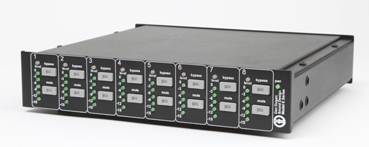Dan Dugan Sound Design has released the Dugan Model E-2 automatic mixing controller for use with multiple live microphones. Incorporating eight channels with Dugan Music System and Dugan Gain Limiting (analogue I/O), 12 channels Dugan Speech System (analog I/O) or 16 channels Dugan Speech System (ADAT digital), this product replaces the Dugan Model D-2 as the company’s top-of-the-line automatic mixing controller with analog I/O. It may be operated from the Dugan Control Panel for Java (included in the purchase price), the Dugan iPad app that provides the Dugan panel on portable devices, the Model CP-2 physical control panel, or the front panel mute and bypass buttons. The Model E-2 links with all other digital Dugans to form larger systems.
- “The Model D-2 was a popular option for users needing analog I/O, but in the past few years advances in technology have made it possible to deliver the same technologies within a smaller chassis and at a lower price,” said Dan Dugan. “This updated unit will be very useful for customers who are working within tight spaces or who need portability in their analog Dugan system.”
- Analog audio connections are made through a DB-25 connector; readily available cable squids can be used where XLR connectors are desired. I/O may also be switched to ADAT optical connectors, as in Dugan’s other E-series controllers. The E-2 can be operated from the Dugan Control Panel for Java (included in the purchase price), an iPad app that incorporates the Java panel into portable devices, the Model CP-2 physical control panel (optional; two rack unit height) or the mute and bypass buttons on the E-2’s front panel. To make larger systems, the Model E-2 links with all other digital Dugans, including the Models D-2, D-3, E-3, E, E-1, E-1A, Dugan-VN16 and Dugan-MY16. Rack mounting accessories are included to mount a single unit, and two units may be mounted side by side in a single rack space.
- Dan Dugan Sound Design automatic mic mixing products eliminate cueing errors, reduce feedback and ambient noise pickup, reduce comb filtering from adjacent mics, allow for smooth transitions between talkers, provide consistent system gain no matter how many mics are open, have the ability of handling up to 64 live microphones, and can be remotely controlled.










